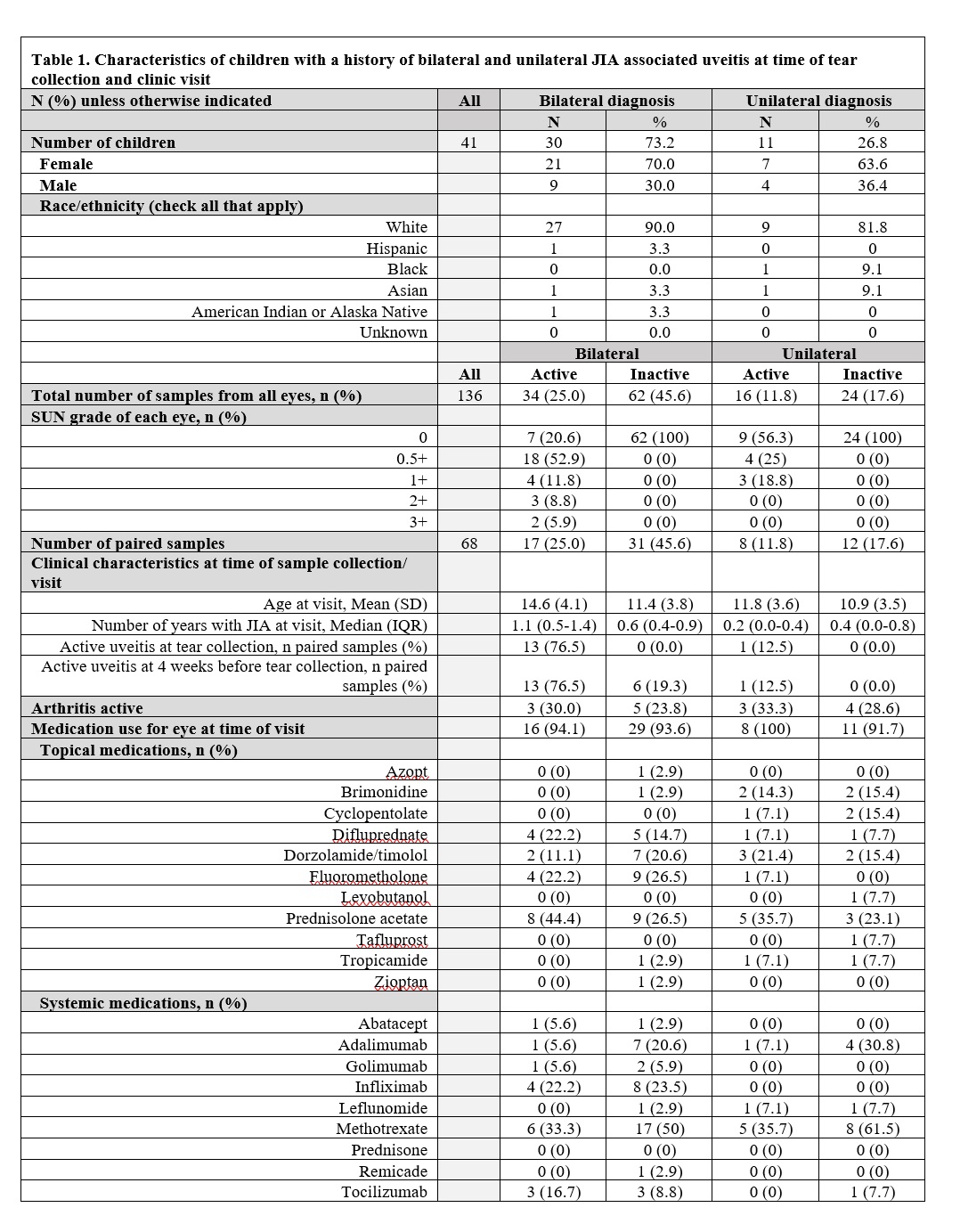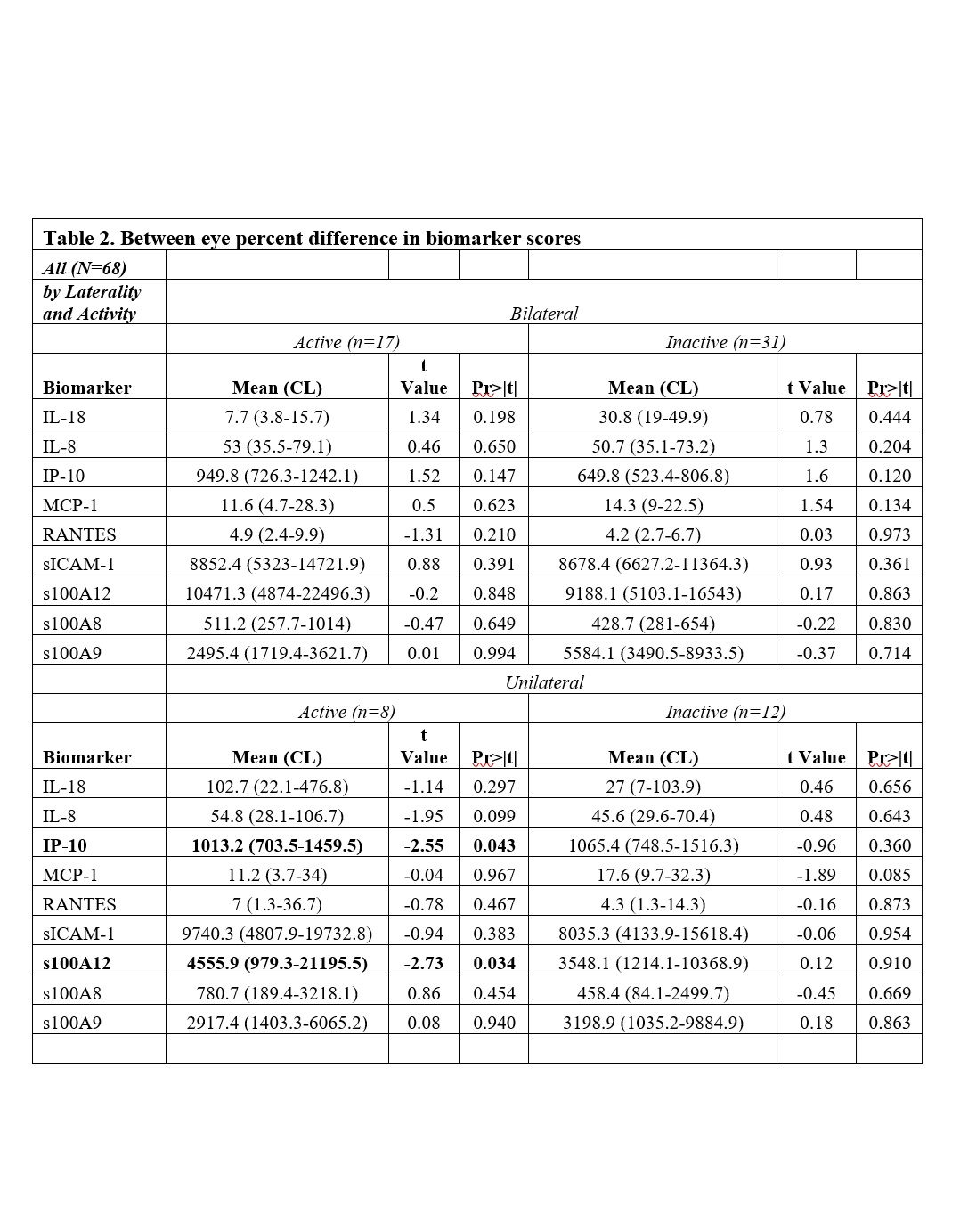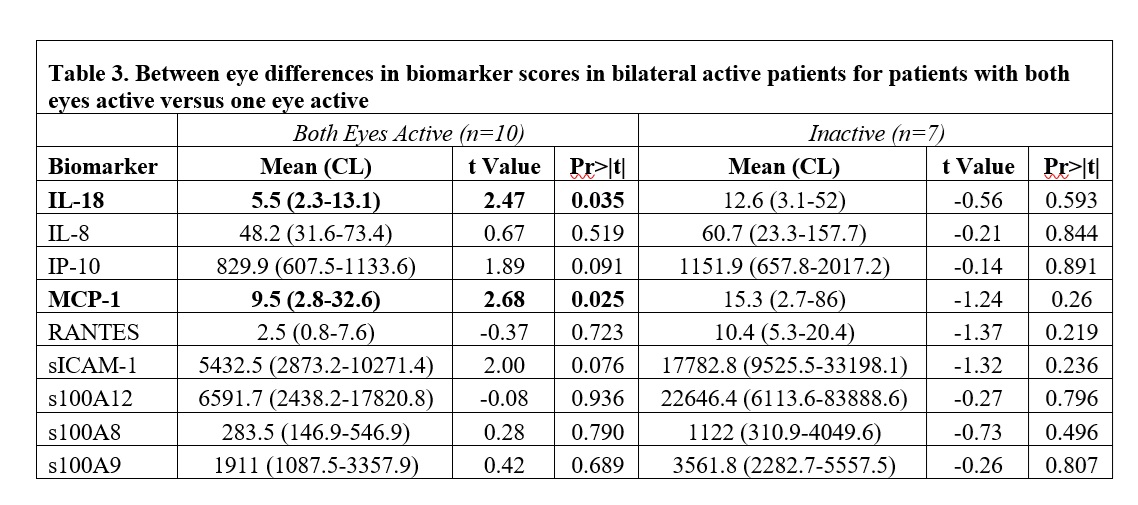Session Information
Session Type: Poster Session A
Session Time: 10:30AM-12:30PM
Background/Purpose: Juvenile idiopathic arthritis-associated uveitis (JIA-U) is an ocular disease that can be unilateral or bilateral. Measurement of ocular inflammation is performed by ophthalmic examination wherein the extent of inflammation can vary between eyes of an affected child. In a study of adults with uveitis, SERPINA3, an acute phase protein, was increased in the tear samples of the unaffected eyes of patients with unilateral anterior uveitis compared to healthy controls. Our aim is to determine if tear-based biomarker levels differ in the affected and controlateral eye based on the presence/degree of eye inflammation.
Methods: In our cross-sectional study, we collected tear fluid by Schirmer strips from JIA-U children who were older than 5 years of age. JIA-U activity was graded according to the Standardization of Uveitis Nomenclature (SUN) criteria. Inactive JIA-U was defined as anterior chamber (AC) cells=0, and active was AC >0.5+. Only children with samples from both eyes were included. Cytokines, chemokines and S100 proteins were measured by Luminex and ELISA assays. Children were grouped by history of bilateral or unilateral uveitis. We compared levels of these inflammatory mediators in both eyes by laterality and grade of inflammation at time of clinical examination. History of bilateral uveitis: a) both active eyes, b) one active eye to one inactive eye, and c) two inactive eyes. History of unilateral uveitis: a) one active eye or b) one inactive eye to the unaffected contralateral eye. Each eye biomarker score was logged to the 10th in order to create a normal distribution for that biomarker. Paired T-Tests were used to determine if there were statistically significant differences in the mean percent biomarker level of each eye per patient for each biomarker.
Results: Demographic and treatment characteristics for the 41 patients are found in table 1. Thirty (73%) patients had bilateral JIA-U while 11 (27%) had unilateral JIA-U. The 41 patients contributed 68 paired samples (both eyes), 17 pairs had bilateral JIA-U active eyes (10 with both eyes active and 7 with one eye active), 31 pairs bilateral inactive (both eyes inactive), 8 pairs unilateral active, and 12unilateral inactive. In children with bilateral active JIA-U, we did not observe significant difference, while in children with unilateral active JIAU we observed a mean percent difference in biomarker levels between right and left eyes on IP-10 and S100A12 (p0.04 and 0.034) (Table 2). When isolating bilateral pairs with both eyes active, we found mean percent differences in IL-18 and MCP-1 (p0.035 and p 0.025, Table 3).
Conclusion: In conclusion, our results show that IP-10, IL-18, S100A12 and MCP-1 levels differed between eyes of patients with JIA-U based on laterality of involvement and presence and severity of inflammation. No differences were found between the affected and contralateral eye in those with unilateral JIA-U. JIA-U is usually bilateral, but inflammation can vary in the eyes of an individual child. Given that the unaffected eyes in patients with unilateral uveitis and the inactive eye in patients with bilateral uveitis were similar to the contralateral eyes, this suggests possible crossing of inflammatory mediators across the ocular retinal barrier.
To cite this abstract in AMA style:
Maccora I, Pavlenko M, Rodriguez-Smith J, Cassedy A, Altaye M, brunner h, Duell A, Grom A, Hennard T, Miraldi Utz V, Mwase N, Quinlan-Waters M, schulert g, Sproles A, Shantha J, Srivastava S, Thornton S, Yeh S, Angeles-Han s. Comparative Analysis of Tear-based S100 Proteins, Cytokines, and Chemokines Levels in Juvenile Idiopathic Arthritis Associated-uveitis: Insights into Eye Laterality and Severity of Ocular Inflammation [abstract]. Arthritis Rheumatol. 2024; 76 (suppl 9). https://acrabstracts.org/abstract/comparative-analysis-of-tear-based-s100-proteins-cytokines-and-chemokines-levels-in-juvenile-idiopathic-arthritis-associated-uveitis-insights-into-eye-laterality-and-severity-of-ocular-inflammation/. Accessed .« Back to ACR Convergence 2024
ACR Meeting Abstracts - https://acrabstracts.org/abstract/comparative-analysis-of-tear-based-s100-proteins-cytokines-and-chemokines-levels-in-juvenile-idiopathic-arthritis-associated-uveitis-insights-into-eye-laterality-and-severity-of-ocular-inflammation/



